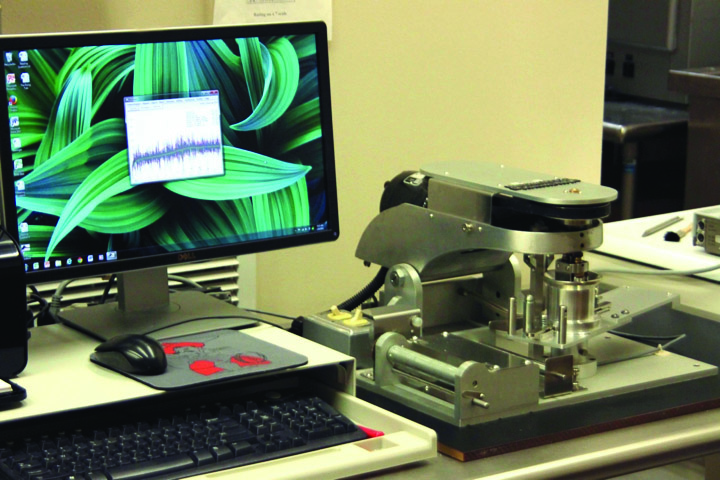Wheat and Flour Quality for Varieties Tested in the 2016 OSU Wheat Variety Performance Tests
General Information
Wheat producers are well aware of the various effects that variety, soil and crop management practices, pests and weather may have on agronomic performance of winter wheat in the southern plains. All of those factors come together and interact to manifest a trait that is easily quantified – grain yield. Likewise, those same factors greatly influence the end-use performance of a variety, but end-use quality is not so easily quantified and may mean different things, depending on where one resides on the grain supply chain from wheat producer to consumer. When choosing a variety, producers will often consider one facet of quality— test weight, or in some cases protein content—but there is much more that determines how a crop or a single variety will perform in the mill or the bakery.
While cash price at the local elevator is not explicitly tied to milling and baking performance, the quality of wheat coming from a particular region or state can affect buyers’ willingness to source product from that area. Modern millers and bakers have numerous purchasing options and are generally unwilling to settle for a product that does not meet minimum industry standards. An area or region considered to have low quality wheat could see reduced cash price relative to current Kansas City Board of Trade (KCBOT) price, thus affecting the farmer’s bottom line. Therefore, wheat quality is everyone’s responsibility.
This report was prompted by the growing need to develop a reliable and relevant database that accounts for varietal differences in certain fundamental aspects of end-use quality, relative to expectations for hard red and hard white winter wheat. In addition to protein content, which is addressed separately in Current Report CR-2135 “Protein Content of Winter Wheat Varieties in Oklahoma – 2016,” the focus here is on physical attributes of the grain that contribute to good milling quality, functional characteristics of the flour or dough inherent to baking quality and actual performance of the baked bread.
Procedures
Approximately 725g subsamples of wheat grain were collected from two field replicates of 46 varieties and two experimental lines in the 2016 OSU wheat variety performance tests conducted at Lahoma and Chickasha. These plots were managed according to Oklahoma Cooperative Extension Service recommendations for maximum yields. Mean yields for these tests were 80 bushels per acre (Lahoma) and 84 bushels per acre (Chickasha). Additional information on management practices is available in Current Report CR-2143 “2016 Oklahoma Small Grains Variety Performance Tests.” Samples were sealed in plastic containers for approximately three months following harvest.
All laboratory procedures were performed in the OSU Wheat Quality Laboratory, the Kansas State University (KSU) Wheat Quality Laboratory, or the USDA-ARS Hard Winter Wheat Quality Laboratory at Manhattan, according to industry standards established by the American Association of Cereal Chemists International (Table 1). Procedures reported here were grouped into three broad categories:
- milling quality, or those parameters associated with the whole kernel and/or which would be especially relevant to the flour extraction process,
- flour quality, or dough-testing parameters associated with straight-grade bread flour and
- bake quality, or those parameters more often used to describe or predict actual baking performance for pan-loaf bread products.
Though not all-inclusive, the attributes reported here represent key indicators of milling performance and bread flour functional performance.
Table 1. Wheat, flour and bake quality tests, test methods, test instruments, and performing laboratory for varieties in the 2015-2016 Oklahoma State University variety performance tests.
| Quality domain | Test | Test Method | Test Instrument | Lab† |
|---|---|---|---|---|
| Wheat quality | Wheat quality | Near-infrared reflectance (NIR) | Perten Inframatic 8611 | OSU |
| Kernel hardness | NIR | Perten Inframatic 8611 | OSU | |
| Kernel hardness | Single-kernel characterization system (SKCS) | Perten SKCS 4100 | OSU | |
| Kernel weight | SKCS | Perten SKCS 4100 | OSU | |
| Kernel diameter | SKCS | Perten SKCS 4100 | OSU | |
| Laboratory milling yield | Straight-grade flour extraction | Brabender Quadrumat Senior Mill (modified shaker system) | OSU, USDA | |
| Flour quality | Flour protein | NIR | Perten Inframatic 8611 | OSU |
| Peak time and mixing tolerance | Mixograph, 10 g flour | National Manufacturing Mixograph with MixSmart software | OSU | |
| Farinograph, 50 g flour | Brabender Farinograph-E | USDA | ||
| Gluten quality | SDS sedimentation with protein adjustment | N/A | OSU | |
| Bake quality | Mix time | Straight-dough bread baking | National Manufacturing Test Baking | KSU |
| Loaf volume | Straight-dough bread baking | National Manufacturing Volumeter | KSU | |
| Grain score | Straight-dough bread baking | N/A | KSU |
†OSU, Oklahoma State University Wheat Quality Laboratory located in Stillwater, OK; USDA, United States Department of Agriculture-Agricultural Research Service Hard Winter Wheat Quality Laboratory located in Manhattan, KS; KSU, Kansas State University Wheat Quality Laboratory located in Manhattan, KS.
Interpretation of Tests
Wheat and Flour Protein
These simple tests are performed using an NIR analyzer (Figure 1), and merely determine the amount of protein present, not the kind or quality, whether in the whole kernel or in the milled product. For hard red and hard white winter wheat, a reasonable target for wheat protein is 12 percent or more. Though rarely, these varieties will produce wheat protein content that exceeds 15 percent or 16 percent when averaged across multiple environments. Other hard wheat varieties may dip below 12 percent, but will rarely average less than 11 percent wheat protein. This level of wheat protein may be acceptable, if combined with a desirable level of protein strength. The type and quality of protein, not the quantity, determines wheat functionality as long as certain market-class expectations for quantity are satisfied. A range of 11.5 percent to 13.0 percent wheat protein constitutes the best expectations for wheat produced in Oklahoma. About 75 percent to 80 percent of the protein present in flour is comprised of glutenin and gliadin, which interact to produce gluten when flour is mixed with water.

Figure 1. Perten Inframatic 8611 near infrared (NIR) analyzer.
Generally, and assuming proper mill settings, wheat shows a loss of about 1.0 to 1.5 percentage units in protein content when milled into straight grade flour (the typical flour used for bread making), as some of the protein residing in the kernel is removed with the bran layers during flour milling. Wheat protein content is expressed on a 12 percent moisture basis, whereas flour protein content is expressed on a 14 percent moisture basis.
Kernel Hardness and Size
The Single-Kernel Characterization System (SKCS) measures several physical attributes of a 300-kernel sample: hardness index or texture, diameter or size (or thickness) and weight (Figure 2). When measured by the SKCS, kernel hardness is manifested as the force required to crush a single intact kernel; softer kernels and more weathered kernels will crush more easily, generating lower hardness index values. When measured by NIR however, kernel hardness is manifested by particle size of ground whole-wheat meal; softer kernels produce smaller particles, again generating lower hardness index values. Having both measurements provides a full-scale view of endosperm hardness, for which the hardness index value varies non-discreetly among varieties, even among hard and soft varieties within the same market class. Desirable values for kernel hardness index fall in the range from 60 to 80 within the same market class, but as with wheat protein content, millers may find bread wheat varieties slightly below or above this range and still provide desirable functional characteristics in the flour. Rarely will a hard red or hard white winter wheat variety grown in Oklahoma average less than 50 or greater than 100 for either measurement of hardness index.

Figure 2. Perten SKCS 4100 used to measure several physical characteristics of wheat kernels, including kernel weight, diameter and hardness.
Whether in a domestic mill or outside the USA, millers prefer high test weight, and consistent and large kernel size. These factors combined allow millers to optimize flour yields, the consummate measure of milling performance. Kernel size can be predicted using SKCS kernel diameter, in which values exceeding 2.50 mm are most desirable. This range might be unattainable in environments where kernel filling is stymied or prematurely ended by disease, drought or many other environmental or management hazards. Because larger kernels are generally heavier kernels, SKCS kernel weight provides another reliable indicator of milling quality, in which values exceeding 30 mg are most desirable. Large or heavy kernels do not necessarily equate with high test weight. High test-weight varieties may be found that produce below-average kernel size, but compensate for smaller size with a more spherical shape and shallow kernel crease to enable greater packing efficiency. Nonetheless, varieties with high test-weight potential and large kernel size truly represent the millers’ choice. Test weight data for this set of varieties and locations is available in Current Report CR-2143 “2016 Oklahoma Small Grains Variety Performance Tests.”
Laboratory Milling Yield
Wheat quality laboratories used in wheat research programs throughout the world employ a small-scale mill to approximate, but not duplicate, the performance on a commercial-scale mill. Regardless of scale, the purpose of this test is to measure the proportion of one or more flour streams produced by a unit of grain. Straight-grade flour is typically generated in a research laboratory, which does not feature the same level of refinement found in a commercial setting. Hence milling yield, or flour yield, determined in a laboratory may run eight or more percentage units lower than commercial extraction rates. The Brabender Quadrumat Senior experimental mill used in the OSU Wheat Quality Laboratory will generate flour yields for hard wheat samples usually exceeding 57 percent (Figure 3). The break rollers on any mill are set though according to the market class of the wheat feeding it. If a soft wheat sample is run through OSU’s mill set for hard wheat, the resulting flour yield will be less than 57 percent. Flour yield this low is a telltale sign of inferior millability for bread wheat applications, especially when used in combination with hardness index measurements, or with molecular marker assays for key hardness genes. Values for flour yield exceeding 58 percent are usually more desirable with the OSU experimental mill. New this year was the addition of milling yield data provided by a newer but similar instrument housed in the USDA-ARS Hard Winter Wheat Quality Laboratory in Manhattan, KS. Varietal differences were highly consistent between instruments, but the milling yield values generated by USDA-ARS more closely approximate those in commercial practice.

Figure 3. Brabender Quadrumat Senior Mill (modified shaker system).
Mixograph and Farinograph Performance
An essential fixture in almost any bread wheat quality laboratory is a recording dough mixer (RDM) called the mixograph (Figure 4). Other RDMs are available and perhaps preferred in a commercial setting, such as the farinograph. The mixograph provides the ultimate stress test by generating quick results in usually less than 10 minutes with very little material (typically 10 grams flour). The farinograph imparts less energy, or less abuse, to a developing dough over a longer duration and requires more material (typically 50 grams flour). Much like an electrocardiogram, the mixogram or farinogram (the visible output of a mixograph or farinograph, respectively) translates dough development into line tracings, or mixing curves, visible on a computer screen. One can visualize the tolerance of a dough as it is subjected to increasing stress from mixing or overmixing. Although the two curves are not directly comparable, common features of the mixogram and farinogram include i) the ascending portion of the curve, which depicts formation of gluten and development of the dough as the flour absorbs water; ii) the peak of the curve that denotes optimum dough development; and iii) the descending portion in which breakdown of the gluten occurs with continued mixing.

Figure 4. The mixograph is used to determine dough tolerance to mixing and overmixing.
Key parts of a mixogram are quantified as corrected mixing time (i.e., adjusted for flour protein content), mixograph tolerance score which is an overall subjective tolerance score and two computer-generated parameters of the mixing curve, its bandwidth and its ascending and descending slope (Figure 5). Mixing time (or peak time) is not a parameter that is easily interpreted as acceptable or unacceptable. In very general terms, poor mixing tolerance may be expressed as a shorter mixing time (less than three minutes) and very high tolerance may be manifested as a longer mixing time (more than 8 minutes), but longer is not necessarily better. Bread flour with short mixing time and good tolerance would have utility in lowering bakery energy costs. Consider also that bread flour that requires an excessively long mixing time could cause production problems in a mechanized commercial bakery.
Figure 5. Mixograms provided by the USDA-ARS Hard Winter Wheat Quality Laboratory, Manhattan, KS. Mixing tolerance ratings on a 0 to 6 scale are 2 (left) and 5 (right).
Mixograph tolerance score is often visually rated on a scale of 0 (very poor tolerance)
to 6 (very high tolerance). Poor tolerance is manifested as a curve with a sharp peak,
followed by a rapid descent and narrowing of the band. Excellent tolerance can be
seen in a curve with a gradual peak and descent with little narrowing of the band.
The angle of ascent and descent is used to compute a mixogram stability value in which
lower values (typically <10) indicate greater stability and thus tolerance. Bandwidth
can be measured at some point on the curve following the peak, where higher values
(typically more than 10 mm at two minutes past the peak) indicate greater tolerance.
Key parts of a farinogram are quantified as peak time (also called dough development
time or mixing time), stability and absorption (Figure 6). A lower peak time implies
a shorter mixing requirement (less than four minutes) and is usually associated with
lower gluten strength. Farinograph stability, unlike mixograph stability, is reported
in minutes, or the amount of time the curve remains above the 500 farinograph unit
(FU) line. Lower stability is less desirable (typically less than 10 minutes for hard
winter wheat), but the stability value of the same variety can vary widely across
environmental conditions, especially across years. The desired range is 10 to 16 minutes.
Greater stability indicates the potential to withstand longer fermentation time during
the bread making process. Absorption indicates the percent of water required to center
the curve at its peak on the 500 FU line, with higher values (preferably more than
60 percent) being more desirable. Farinograph absorption may not equate with bake
absorption, because various ingredients added during baking can affect water absorption.
It is important not to overemphasize dough strength above all else. Producing pan bread from hard winter wheat flour is more about balance than about brute strength – in other words, bakers need a sufficiently strong dough to handle the stress of commercial processing, certainly to contain the fermentation gases, yet pliable enough to rise during baking. Some of this balance may be achieved by blending different grain sources from the same market class with varying dough strength, or by blending two or more market classes.
Figure 6. Farinograms provided by the USDA-ARS Hard Winter Wheat Quality Laboratory, Manhattan, KS, representing very weak gluten (left) and strong gluten (right). Peak time and stability values are 3.9 and 4.0 min (left), and 3.3 and 18.2 min (right).
SDS Sedimentation
This simple laboratory test utilizes the water-absorptive capacity of certain gluten proteins, in the presence of sodium dodecyl sulfate, to predict gluten strength and to some extent loaf volume (Figure 7). Sedimentation values reflect both the quantity and quality of gluten; thus in the OSU WQL, an adjustment is made for flour protein content so the amount of water absorbed primarily reflects gluten quality. Higher values (greater than 6.5 mL) are more desirable.

Figure 7. A sedimentation test is used to determine the quantity and quality of gluten.
Bread Baking
The most effective and direct way to forecast performance in a commercial baking application is to prepare the dough and bake the bread. However, the multitude of bread products available today, and the associated wide range in baking methods and conditions, requires a skeletal approach to experimental baking procedures. A common procedure employed in experimental wheat quality laboratories is the optimized straight-dough bread making method that utilizes 100 g flour, producing what is often called a pup loaf. When used according to industry standards, several attributes of the final baked product may reflect upon functional performance, or functionality, in commercial industry. Three attributes—mix time, loaf volume and grain (or crumb) score—are most relevant. Mix time, comparable to peak time on the mixograph or farinograph, is the time in minutes required to optimally prepare a given dough sample for baking. A skilled test baker looks for smooth, dry and extensible dough characteristics when the dough is adequately developed. Interpretation of the bake mix time, whether short or long, is analogous to peak time mentioned previously, but three to five minutes constitutes a desirable range. As the name implies, loaf volume measures the size of the loaf in cubic centimeters and is determined by volumetric displacement. A desired loaf volume exceeds 850 cc. The internal visual features of the loaf, or grain structure, represent a key attribute of functionality and may be scored on a 0-to-6 scale of poor (0), satisfactory (3) and excellent (6). A desired grain score exceeds 2.
Brief Interpretation of Results
With the addition of a foliar fungicide and the lack of significant drought stress during grain filling at both locations (Chickasha and Lahoma), most varieties were expected to approach their potential grain size and quality in 2016. Overall, wheat protein in these two trials averaged 12.6 percent and kernel weight averaged 33 mg, though the latter varied widely among varieties from 27 mg to 39 mg. Neither indicator of kernel size (kernel weight or kernel diameter) were indicative of flour yield determined independently on two experimental mills. Varieties with flour yields consistently in the desired range, relatively high kernel weight and diameter, acceptable hardness scores above 60, and/or wheat protein values averaging 12.5 percent or higher were considered to have the most desirable milling quality. Notable examples included Bentley, Billings, Doublestop CL Plus, Ruby Lee, SY Grit, T158 and WB4458. Varieties with undesirable milling quality included LCS Chrome, LCS Pistol, Long Branch and OK12912C.
As expected, the capacity to produce flour had no bearing on quality or functionality of the flour. For example, flour yield and farinograph stability values produced correlation coefficients less than r = 0.15. Everest, Larry, WB4458 and LCS Wizard exhibited acceptable milling attributes but below-average dough strength. SY Grit exhibited exceptional milling quality, but unacceptable overall flour quality. Other varieties with undesirable attributes for mixing tolerance included LCS Chrome and TAM 204. Varieties exhibiting consistently good flour quality attributes included 1863, Doublestop CL Plus, Ruby Lee, SY Monument and TAM 114.
Loaf volume was uncharacteristically low at both sites, even though protein content was normal. Varietal loaf volumes and grain scores were inconsistent between locations, making it difficult to detect significant differences among varieties for those attributes averaged across locations. One peculiar, but not unexpected, trend was observed in the variety LCS Chrome. Though its mixing tolerance was below average, loaf volume and grain score ranked consistently high across locations. LCS Chrome appears not to tolerate excessive abuse during mixing, but with optimal mixing consistently good bake quality may result. On the other hand, TAM 114 carries the distinction of strong-gluten wheat, with longer-than-average mixing times and above-average mixing tolerance.
Based upon this data sample, and considering all attributes reported, varieties considered less desirable for grain production in Oklahoma include LCS Wizard and TAM 204. Varieties considered most desirable for grain production include TAM 114 and Ruby Lee.
David Marburger
Former Small Grains Extension Specialist
Brett Carver
Wheat Breeder
Connie Estes-Shelton
Senior Agriculturalist
Rebecca Miller
Director, KSU Wheat Quality Laboratory
Richard Chen
USDA-ARS Food Technologist


